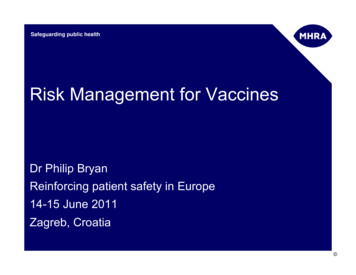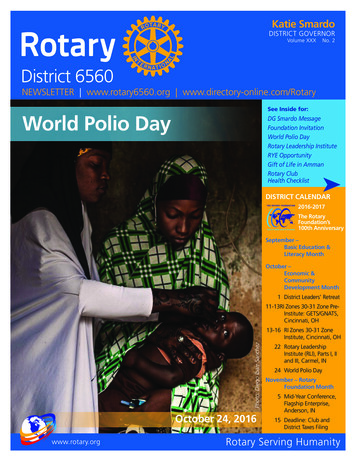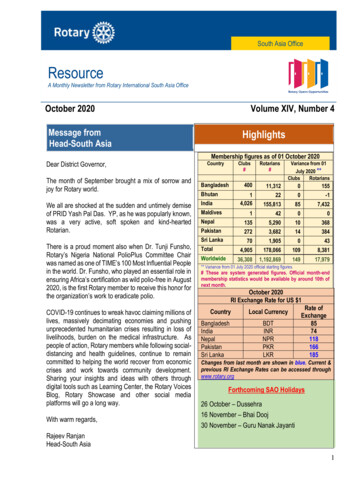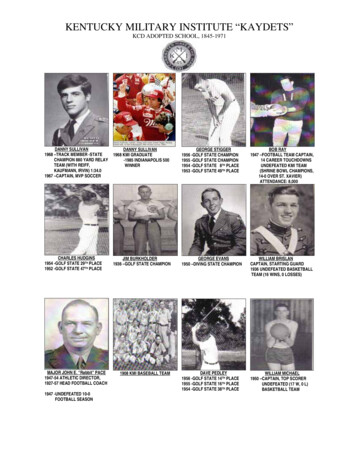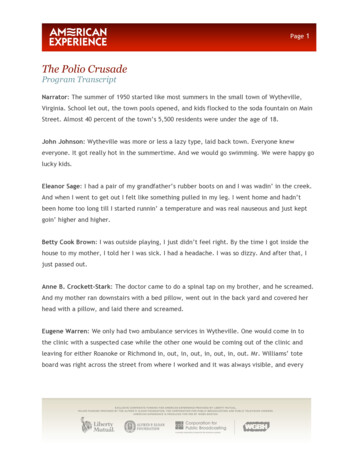
Transcription
Page 1The Polio CrusadeProgram TranscriptNarrator: The summer of 1950 started like most summers in the small town of Wytheville,Virginia. School let out, the town pools opened, and kids flocked to the soda fountain on MainStreet. Almost 40 percent of the town’s 5,500 residents were under the age of 18.John Johnson: Wytheville was more or less a lazy type, laid back town. Everyone kneweveryone. It got really hot in the summertime. And we would go swimming. We were happy golucky kids.Eleanor Sage: I had a pair of my grandfather’s rubber boots on and I was wadin’ in the creek.And when I went to get out I felt like something pulled in my leg. I went home and hadn’tbeen home too long till I started runnin’ a temperature and was real nauseous and just keptgoin’ higher and higher.Betty Cook Brown: I was outside playing, I just didn’t feel right. By the time I got inside thehouse to my mother, I told her I was sick. I had a headache. I was so dizzy. And after that, Ijust passed out.Anne B. Crockett-Stark: The doctor came to do a spinal tap on my brother, and he screamed.And my mother ran downstairs with a bed pillow, went out in the back yard and covered herhead with a pillow, and laid there and screamed.Eugene Warren: We only had two ambulance services in Wytheville. One would come in tothe clinic with a suspected case while the other one would be coming out of the clinic andleaving for either Roanoke or Richmond in, out, in, out, in, out, in, out. Mr. Williams’ toteboard was right across the street from where I worked and it was always visible, and every
Page 2once in a while we’d go to the front door and look out and then every time another one camein with diagnosis, well, they changed the count.Anne B. Crockett-Stark: Daddy and Mama took everything Sonny owned, all of his clothes, hisbed, his chest of drawers, and he had a fabulous comic book collection. And they tookeverything out to the middle of the garden, and they just made a pile and burned everythinghe owned. They were told to do that, so that we would not get it.Narrator: Polio was hitting Wytheville harder that year than any place in the country.Eugene Warren: It became more and more evident that we were really in trouble, andwithout knowing what to do — or how to stop it, or how to get away from it — we were juststuck with it. You-you just couldn’t pick up everybody and leave and you couldn’t set thewhole town on fire. So it was a, it was almost, not hopeless, but it was gettin’ pretty closethat way.Narrator: Since the turn of the 20th century polio, also known as infantile paralysis, hadbecome an increasingly menacing fact of American life. Highly contagious, the polio virustended to strike during the summer.Samuel L. Katz, scientist: It was very reliable. Come June, July you began to see cases ofpolio and they continued on through September.Narrator: The symptoms ranged from a mild headache and nausea, to muscle weakness,paralysis or death.Kathryn Black, writer: One never knew, how it would go. Would it pass through the body andthe person would get up out of bed, few days later, just fine? Would there be one legdamaged? Would both arms?
Page 3Julius Youngner, scientist in Salk’s lab: The paralytic effects would last for life. And youdidn’t have to look very far, to see people who had been crippled with polio, and crippled inin terrible ways.Narrator: In 1921, the disease struck an especially prominent citizen just as his political starwas on the rise. Polio usually targeted children, but Franklin Delano Roosevelt was 39. Aftercontracting a sudden fever and chills, he lost the use of both of his legs.Kathryn Black, writer: FDR was an enormous landmark in the whole history of polio. The factthat he came down with polio changed the course of the disease in this country.Narrator: Roosevelt worked to restore both his body and his career. He bought a remoteGeorgia resort whose spring-fed baths were reputed to have healing powers, and turned itinto the Georgia Warm Springs Foundation, committed to rehabilitating polio patients fromaround the country. In 1928 a still paralyzed but vital FDR fought his way back onto thenational political stage. To keep the fight against polio alive Roosevelt turned to his lawpartner, Basil O’Connor — a man who knew little about polio, but a great deal about powerand persuasion. “I was never a public do-gooder,” O’Connor declared, “and had no aspirationsof that kind.” Short tempered and relentless, he was a working class Irishman who had to digand fight for everything he had achieved.David M. Oshinsky, author, Polio: Basil O’Connor has no interest in being the head of theWarm Springs Foundation. But he is so loyal to Franklin Roosevelt, and he really believes theonly way to ensure FDR’s political career, is to take over this institution that is so close toFDR’s heart.Narrator: With Roosevelt now in the White House, O’Connor worked tirelessly to keep theorganization afloat. America was experiencing the worst economic depression in its history,
Page 4and charities’ traditional source of funding — donations from the rich — had completely driedup. Worse still, the number of cases of polio continued to rise.David M. Oshinsky, author, Polio: What made polio so questionable, what made it so hard forpeople to get a grip on, was that at the very time America was becoming a cleaner, moreantiseptic society, the polio rates were going up dramatically.Narrator: In time, scientists would unlock some of polio’s mysteries: they would learn thevirus entered the body through the mouth; that it passed from person to person throughcontaminated water, food or physical contact. They would come to understand that modernsanitation actually helped explain the prevalence of the disease — infants in cleanenvironments were less likely to be exposed to the virus and develop life-long immunity.Paul A. Offit, scientist: Before improvements in sanitation, all children were born withantibodies against polio. When we had improved sanitation, children started to becomeexposed to polio later and later in life, at a time when those antibodies they had receivedfrom their mother had already disappeared. And that’s why you saw an emergence of thedisease.Narrator: In 1938, O’Connor didn’t know much about the science of polio. What he did knowwas that polio patients depended on private charities like his, not the government, for help.Without a new way to raise money, his foundation could offer little more than hope. It wastime, he decided, to try something bold.Eddie Cantor (archival): The only way to fight infantile paralysis is with money. And so I’masking you tonight to send a dime to President Roosevelt at the White House.Narrator: Enlisting celebrities to the cause, O’Connor made an unprecedented appeal to theAmerican public.
Page 5Mickey Rooney (archival): Judy when I spend a dime on myself for some little luxury likethis, I always think about those unfortunate kids and how far just a dime will go towardshelping.Judy Garland (archival): Gee Mickey, we don’t know how lucky we are and how much wehave to be thankful for with our health and our happiness .Narrator: The campaign was dubbed the March of Dimes.Judy Garland (archival): Can I put a dime in your envelope?Mickey Rooney (archival): Oh, you know that you can. And that’s what every good Americanshould do – join the March of Dimes, send yours to president Franklin Roosevelt in the WhiteHouse.Judy Garland (archival): Washington, DC.Narrator: O’Connor waited anxiously to see if his gamble would pay off. The March of Dimescampaign exceeded all expectations, raising 1.8 million dollars, a staggering sum.David M. Oshinsky, author, Polio: What O’Connor realized was that this was a fundraisinggold mine. This turns the fundraising on its head. You no longer want big donations from thefew. You want small donations from the millions. No one is too poor to give a dime to help akid walk again.Narrator: O’Connor pledged to provide care for every polio patient in America – to pay fordoctors, nurses and the most up to date rehabilitation. He would even invest in scientificresearch aimed at stopping polio forever.
Page 6David M. Oshinsky, author, Polio: Basil O’Connor was no scientist, but he was a greatadministrator. He knew how to organize, he knew how to centralize, he knew how to focus.Narrator: Every summer more and more children were infected with polio. O’Connorunderstood that he was in a race against time.Larry Becker: I was very active and outgoing, and grew up in a time and a place when kidshad lots of independence and minimal supervision. Just a few inflexible rules, like “be homefor dinner.” I was 13. I was just starting to lean out and get kind of fast on the tennis court,and I was pretty happy with the way things were going.Narrator: Larry Becker grew up in Hastings, Nebraska. He was a boy scout, deliverednewspapers and played trumpet in the school band.Larry Becker: My legs gave out as I was pedaling my ice cream cart home for lunch.Narrator: Larry became delirious with fever as the polio virus penetrated his central nervoussystem, infecting and destroying the nerve fibers that controlled his muscles.Larry Becker: It’s like every muscle in your body is extremely sore. It’s very sensitive to thetouch, and just aches. I lost not only my leg muscles, but I lost also neck muscles and, mostimportantly, the diaphragm. I began to have trouble breathing, and I remember the last strawfor me was when I lost the use of my biceps. I was afraid of not so much of pain, but of loss ofcontrol. My parents were in and out of the room. They were being given very bad news. Therewasn’t much hope that I was going to survive.
Page 7Film narrator (archival): You’ve never seen me but I’m sure you’ve seen my shadow. I’mnever invited but I’ve been an invisible guest in practically every kind of home. This is whatI’ve been looking for .Narrator: To keep up the fundraising momentum, O’Connor shifted tactics.Film narrator (archival): As you probably know, I’m very fond of children, especially littlechildren. I have no prejudices. I’m quite impartial.Narrator: The March of Dimes’ new message was a frightening one: polio could strike anyone,anytime.Julius Youngner, scientist in Salk’s lab: You went to a movie and there was a little shortsubject about polio.Doctor (archival film): Memorial Hospital please, Infantile Paralysis.Julius Youngner, scientist in Salk’s lab: They would pass a cup row by row something to putwhatever change you had in it. Polio was brought home every day to families all over theUnited States.Newsreel narrator (archival): In New York the March of Dimes campaign is inspired by BasilO’Connor, Jimmy Durante, Larry and Barry Pelliteri during the past few years the polioepidemic has been on the increase fight polio tonight with your porch lights at seven.Narrator: The campaign worked. The March of Dimes grew to 3,000 local chapters, creating anetwork that reached millions, and raised millions – by the late 1940’s as much as 22 milliondollars per year. But O’Connor’s campaign told only part of the story. While polio could bedevastating, the chances of contracting an acute case were quite small; of being paralyzed,
Page 8smaller still of dying from polio, extremely remote. Many more Americans died from caraccidents, or tuberculosis.David M. Oshinsky, author, Polio: What the March of Dimes did was to turn an awful butrelatively uncommon disease into our national disease and our national crusade. BasilO’Connor’s feeling was: We’ve got to raise money for this. The best way you raise money wasbasically to scare the hell out of the American public.Kathryn Black, writer: It’s hard to imagine today I think how pervasive the fear was, and howembedded in the American psyche.Narrator: The fear overwhelmed common sense. Every summer, in Wytheville and hundredsof towns across the country, people took extraordinary measures to avoid polio. They evensprayed the pesticide DDT despite the fact scientists had proved flies did not spread the virus.Eugene Warren: Not knowing which way to turn, what’s causing it, people looked for all sortsof places to put the blame. Some of 'em were ludicrous and some of 'em weren’t.Anne B. Crockett-Stark: Daddy said people just rolled up their car windows and put bandanasaround their faces and zoomed through our town.John Johnson: We didn’t go on Main Street. We didn’t go anywheres near town during thepolio epidemic.Betty Cook Brown: For the longest time, no one would bother to call, come, or get anywherenear our house. They were afraid. They didn’t want to catch polio.Eleanor Sage: They didn’t want my mother and daddy to come in some of the stores. Theyjust didn’t want 'em around.
Page 9Anne B. Crockett-Stark: People did as little as possible, isolated themselves, and just prayedthey wouldn’t get it.Narrator: In 1949, O’Connor took the campaign against polio to a new level. For more than adecade scientists funded by the March of Dimes had focused on developing the only viablesolution to stop polio – a vaccine. Now, O’Connor declared, the long-awaited miracle was “insight.” His message raised hopes, and dimes, from an anxious public. But within the scientificcommunity there was a very different reaction: a vaccine, most researchers believed, wasstill years away – if it worked at all.Kathryn Black, writer: We lived in this little housing development in Phoenix. It was youngfamilies everywhere, and the population was just booming. Couples just like my family –father back from the war, mother had had a career and let it go to have children. I was fouryears old, my brother was six, my parents were 28. Life was pretty simple, pretty happy. Oneday my mother came down with a backache. And the doctor examined her, and my fatherremembers the doctor saying, “I think she has polio, but don’t worry. It doesn’t look like aserious case, but we have to put her in the contagious ward, where she’ll be isolated.” Andthings only got much, much worse from there. She survived that night, but she was paralyzedfrom the neck down. I have no memory of her going away. She disappeared overnight. Wewent to bed one night and our mother was in the next room. We woke up the next morningand she was gone.Narrator: In 1951, two years after his promise of an imminent polio vaccine, O’Connor hadlittle to show. Then, in September, traveling home from a conference in Europe, he met ascientist as driven and impatient as O’Connor himself. Jonas Salk was a 36-year-oldresearcher at the University of Pittsburgh.
Page 10Julius Youngner, scientist in Salk’s lab: He was somebody who had great confidence inhimself. “Ambitious” is too mild a word. He was super-ambitious.John Troan, journalist: He was very aggressive on what he was doing. When I first met him,he looked very intense and he remained that way. I mean, never changed. Real intensivepersonality.Narrator: O’Connor and Salk hit it off right away.Peter Salk: Their personalities just meshed. Both shared big dreams, they shared big goals,and they saw in each other someone who was complementaryNarrator: Salk’s big goals included plans for an unorthodox polio vaccine. Up until now,leading edge polio researchers had focused on making a vaccine from a live virus, like thevaccines for yellow fever and smallpox — a complex and time consuming process.Julius Youngner, scientist in Salk’s lab: Live virus vaccines were the gold standard of virusvaccine. The whole scientific community of experts said that the only vaccine that wouldwork for polio would be a live vaccine.Narrator: Jonas Salk disagreed. His experience developing a flu vaccine told him that a killedvirus vaccine was both possible, and faster to produce.David M. Oshinsky, author, Polio: Salk had been trained to believe with influenza and otherviruses that if you took the virus and you killed it and injected it into someone’s arm, youcould, trick the body’s immune system into believing that an invader had come, and the bodywould produce strong and lasting antibody protection.
Page 11Narrator: Proponents of the live virus vaccine dismissed Salk’s ideas as ill-conceived scientificheresy. Most notably, Albert Sabin.Samuel L. Katz, scientist: Dr. Sabin had already established a reputation as a sound andimaginative innovative investigator. He was a little bit bombastic. He was a little bitintolerant of other people’s ideas. He was always convinced that his own were correct andmost of the time he was right.David M. Oshinsky, author, Polio: Albert Sabin had been working for a number of years on hislive-virus vaccine. Sabin believed that his vaccine was the perfect polio vaccine. He also knewthat it would take longer to develop, and the constant conflict he had with Basil O’Connorwas over time. “I need the time to perfect my vaccine.” Basil O’Connor wanted everythingdone now. Albert Sabin simply believed that science went by its own clock. And that theMarch of Dimes should wait until his vaccine was ready.Narrator: Salk was a mere “kitchen chemist,” Sabin would say, whose hasty work posed alurking danger to human health. But Basil O’Connor didn’t listen. Salk’s lab would become aleading recipient of March of Dimes support.David M. Oshinsky, author, Polio: What made Basil O’Connor so strong about Jonas Salk, wasthat O’Connor finally believed he had met a scientist who understood that kids were dyingevery day, and that speed was important.Julius Youngner, scientist in Salk’s lab: Jonas was swimming against the current. He was ayoung whippersnapper who came out of nowhere, and suddenly is taking on thisresponsibility, and not only that, but getting the support of Basil O’Connor, because Jonasconvinced Basil O’Connor that we were going to do it.
Page 12Narrator: At his lab at the University of Pittsburgh, Salk’s race to find a polio vaccine tookoff.Samuel L. Katz, scientist: Dr. Salk’s laboratory was like a factory in that he had a largenumber of people. They were all doing what he dictated they do. In contrast, manylaboratories were more interested in expanding scientific perspective and not necessarily asgoal driven.Narrator: The pressure he put on his staff was unrelenting. “Salk thought big,” one colleagueobserved. “He wanted to leap, not crawl.”Julius Youngner, scientist in Salk’s lab: This was a heavily, heavily financed, expensiveproject. We used thousands of monkeys. We had resources beyond, those that, any of theother researchers had.David M. Oshinsky, author, Polio: He almost immediately could see that his killed-virusvaccine, at least in animals, was very, very successful. His tests with monkeys wereextraordinary. They had high antibody levels. None of them seemed to get polio. He knew hewas on the track of something very important.Narrator: With the success of his trials on monkeys, Salk pressed for the next necessary, butrisky step — to test his vaccine in humans. O’Connor eagerly agreed. But Sabin issued awarning: Salk was moving too quickly; his plan posed a serious threat to innocent lives.O’Connor ignored Sabin’s objections. Salk’s human trials would proceed as planned. On July2, 1952 assisted by the staff at the D.T. Watson Home for Crippled Children Jonas Salkinjected 43 children with his killed virus vaccine.
Page 13Samuel L. Katz, scientist: The idea of going into institutions where there were children whowere damaged by various diseases and using or exploiting them as subjects for these studieswas not regarded in the same way it is today.David M. Oshinsky, author, Polio: There was no real sense of what we would call informedconsent. If you wanted to test, as Jonas Salk did, you went to the director of an orphanage,or what was called a home for the feeble minded, and you tested.Narrator: A few weeks after the Watson tests, Salk injected children at the Polk State Schoolfor the retarded and feeble minded. Then he administered the vaccine to his family andreceived a shot himself. No one got polio. Blood tests showed that, like his lab monkeys, hishuman subjects had elevated levels of polio fighting antibodies. A vaccine, Salk believed, waswithin reach. 1952 saw the outbreak of America’s worst polio epidemic. More and more olderchildren and adults were contracting the disease. The older you were, the greater the risk ofparalysis or death. Hospital wards were crowded with machines that helped paralyzedpatients breathe. They were called iron lungs.Larry Becker: My father came in to explain to me that they wanted to put me in the iron lungand simultaneously one was moved into my room. It’s a huge piece of equipment, and lookedscary, and I didn’t know what it meant. Your head is disconnected from your body. You can’tsee your body. And in my case, I couldn’t move anything at first. And I was veryuncomfortable because of the pain in my muscles. You have to get used to the fact that youdon’t control your respiration rate. And when you’re first put in, at least it was the case forme, since I was struggling so much to breathe, I just relaxed right into it.Kathryn Black, writer: The development of the iron lung was a great scientific advancementin medical care. It saved plenty of lives. It certainly saved my mother’s life, but it also was itsown terrible existence. My mother was flat on her back, being breathed by a machine, tendedby people through little portholes on the side of the machine, seeing nothing of the world
Page 14except what she could see through a mirror above her face. What happens to your mind, dayafter day, night after night?Narrator: For most the iron lung was a temporary measure to help them survive during themost acute phase of the disease. For others, it was permanent.Woman in iron lung (archival): Hello there. This is a wonderful day for me. Five minutes outof my iron lung. Five minutes out of my little prison. My kind and friendly prison.Larry Becker: The first time I got out of the iron lung I saw the doctor cry because of thedifficulties I was having on the bed. That was a shock, and that soon turned into a kind of aself-disgust, I think, or shame which I didn’t articulate, but I just wanted to hide. I was 13years old. I thought I was immortal. I don’t ever remember being afraid that I would die. Iwas afraid I wouldn’t get better.Narrator: Surveys showed that, apart from the atomic bomb, Americans’ greatest fear waspolio.Kathryn Black, writer: People had put up with polio for a really long time, and they wantedit over. They wanted it done with. The American public wanted that vaccine.Narrator: On November 16, 1953 Basil O’Connor made a stunning announcement; The Marchof Dimes would finance, plan and coordinate an unprecedented human experiment, testingSalk’s vaccine on hundreds of thousands of school children. Reaction from within thescientific community was scathing. Injecting Salk’s vaccine, Albert Sabin warned, might causepolio, not prevent it.John Troan, journalist: Sabin was very aggressive. And he could be very abrasive. He wastrying everything to postpone the field trial, to downgrade the Salk vaccine. He said, “This
Page 15vaccine isn’t ready to be tested. We should wait five more years. We should wait 10 moreyears.”Narrator: O’Connor refused to wait. With another polio season looming, he would let nothingstop the trials. “This is one of the most important projects in medical history,” he wrote toparents across the country. “We feel sure you’ll want your child to take part.”Kathryn Black, writer: As a parent today, it’s unimaginable that I would be one of thosepeople pushing my child to the front of the line, saying, you know, “Put the polio vaccine inmy child first, and let’s see if it works.”David M. Oshinsky, author, Polio: You are asking the parents of American to line up theirkids for a vaccine that no one is sure how well it works, and no one is certain that it isperfectly safe. It has really not been tested that much on humans. This is an enormous leap offaith.Narrator: On April 26th, 1954, The March of Dimes began field trials. Randy Kerr, a six-yearold in McLean, Virginia was the first to receive Salk’s vaccine. By June nearly two millionchildren had taken part. It was the largest human experiment in American history. Parentswould have to wait for nearly a year to learn the results. On the morning of April 12th, 1955,the March of Dimes made their announcement.John Troan, journalist: There was a build-up to the report on the field trial. Everybody wasinterested. Everybody was waiting, waiting, waiting. Does it work? Does it work?Kathryn Black, writer: There was no bigger story at that time. It was held in secrecy like nostate secret ever could be. This news was awaited around the world.Narrator: A press release would reveal the findings everyone was waiting for.
Page 16John Troan, journalist: They were going to bring it up on an elevator. The press room wasover crowded. We were elbow to elbow. The public relations man steps off the elevator withthe dolly, and he can’t move into the press room. Everybody ganging around him, guys werejumping over desks. The fellow climbed up on the dolly and he began flinging these things outleft and right. It was bedlam.Announcer (archival): CBS News presents a Special Report.Winston Burdett (archival): The Salk polio vaccine is a success. The vaccine works.Narrator: Factory whistles blew, school children cheered, parents wept.John Troan, journalist: Everybody was so happy. It was the most satisfying story I wouldcover in 44 years in journalism.Peter Salk: The relief that was brought about by all of a sudden having something that couldbe done to stop this, it was- I think that was just overwhelming.Paul A. Offit, scientist: Jonas Salk was viewed as an American hero. This awful disease hadnow been conquered by this man who we had funded, this scientist who was us.David M. Oshinsky, author, Polio: This vaccine vindicated 20 years of giving dimes, 20 yearsof volunteering. It was a victory for millions of faceless people who had done what they couldto end the scourge of polio.Narrator: Five years before the disease had raged through Wytheville. Now, the community,like thousands of others across the country, would finally receive the vaccine.
Page 17Anne B. Crockett-Stark: I remember hearing about Dr. Salk, Dr. Salk, and how exciting itwas. That man saved the world from polio.Narrator: Less than a month after vaccinations began, the nation’s triumphant polio crusadewas brought to a screeching halt.Leonard Scheele (archival): As surgeon general of the public health service, I recommendedthe day before yesterday that vaccination programs against poliomyelitis be temporarilypostponed .Narrator: Thousands of children vaccinated with the new Salk vaccine had become sick.Hundreds would be permanently paralyzed. A handful would even die.David M. Oshinsky, author, Polio: We have gone from this amazing situation of euphoria, adisease on the run, to the vaccine itself producing additional cases of polio. All polio vaccineis taken off the market until the government can pinpoint exactly what has gone wrong.Narrator: Investigators soon learned that all the sick children had been injected with a badbatch of vaccine, made in Berkeley, California. After a hasty and poorly staffed governmentscreening process the vaccine had been deemed safe. In fact it had contained virulent livepolio virus. Cutter Laboratories wasn’t alone — all the pharmaceutical companies were havingdifficulties mass-producing Salk’s formula. One scientist especially, felt vindicated — AlbertSabin.David M. Oshinsky, author, Polio: Sabin had always been of the mind that not only was theSalk vaccine not effective but potentially was unsafe. After Cutter, Albert Sabin simply wentaround to anyone who would ask — and many people did — saying, “I told you so.”Narrator: Despite the crisis, O’Connor’s confidence in Salk’s vaccine never faltered.
Page 18Reporter (archival): What do you see for its future?Basil O’Connor (archival): Well I can only say to you that I see that its future is still a goodsound, safe vaccine, that will protect the people .Paul A. Offit, scientist: The Salk vaccine was licensed at a time when we basically didn’thave vaccine regulation in this country. The government learned that having 10 peopleoversee vaccines, and frankly doing it on a part-time basis, was not good enough. The Cutterincident was a painful lesson about the fact that we needed much better oversight.Narrator: In the wake of the tragedy, manufacturing standards would be tightened, andgovernment regulation increased. But, only eight days after the surgeon general announced ahalt, the nation’s polio vaccination program resumed. Americans continued to vaccinate theirchildren. They had waited years for the polio vaccine. They were not about to wait anylonger. The nation’s polio vaccination program, lead by the March of Dimes — now supportedby the United States Government — proved safe and overwhelmingly effective. Within just afew seasons the number of polio cases in the United States decreased by 50 percent.Memories of summers filled with fear began to fade. By 1962 Albert Sabin’s live virus vaccinewas finally ready. An oral vaccine, it was easier to administer and cheaper to produce thanSalk’s. The years to come would see the scientific efforts of both Salk and Sabin pay offdramatically. Polio, once one of America’s most feared diseases, became largely a thing ofthe past.Kathryn Black, writer: Nobody cared about polio anymore. It was over. My mother, cominghome from the rehab center, it is not the story of triumph and conquering. It is the story ofdefeat. After a year of treatment, it didn’t fix her. It didn’t fix our family. Our family haddisintegrated around her.
Page 19Narrator: When Kathryn Black was six years old, her mother died. Larry Becker spent two anda half years in the hospital. He learned to breathe on his own by using the muscles in hisneck. His arms remained
Anne B. Crockett-Stark: Daddy and Mama took everything Sonny owned, all of his clothes, his bed, his chest of drawers, and he had a fabulous comic book collection. And they took everything out to the middle of the garden, and they just made a pile and burned everything he owned. They were told to do that, so that we would not get it.






